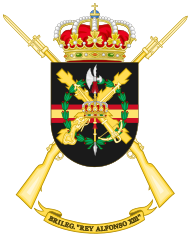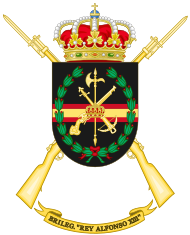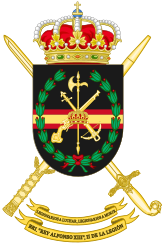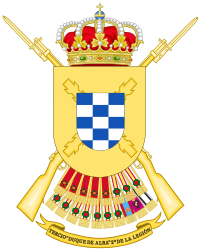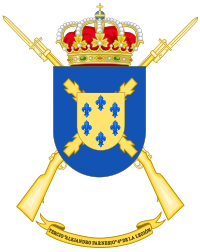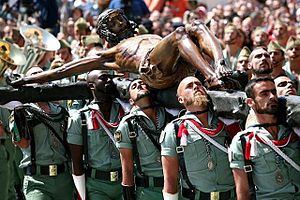Spanish Legion
The Spanish Legion, also known simply as the Legion, is an elite military force led and created in 1920 in Ceuta by José Millán Astray, framed within the Land Force of the Spanish Army. It currently consists of the "Gran Capitán", 1st of the Legion, and "Duque de Alba", 2nd of the Legion, and of the "King Alfonso XIII" II Brigade of the Legion, a BOP made up of its Once by the tercios "Don Juan de Austria", 3rd of the Legion, and "Alejandro Farnesio", 4th of the Legion, plus other maneuver and logistical support units. The brigade is part of the "Castillejos" Division, Light Forces until 2015, while the "Duque de Alba" and "Gran Capitán" Tercios belong to the general commands of Ceuta and Melilla, respectively.
The Legion or Third of Foreigners, as it was originally called, was the result of the efforts of the then Infantry Commander José Millán-Astray. The unfavorable outcome of the Spanish arms in the colonial wars in North Africa also created disturbances in the country. Millán-Astray came to the conclusion that Spain needed a body of professional soldiers, not replacement ones, with a morale and esprit de corps that were comparable to those of the French Foreign Legion. The Legion is the culmination of that personal project.
After its intervention in the war in Morocco and the restoration of the legality of the uprising against the democratic government of the Republic, called the Asturias Revolution of 1934, the Legion participated together with the rebel side (with General Franco) in the war Spanish civilian. Later he intervened in the Ifni War of 1957-1958 and in the crisis for the decolonization of the Spanish Sahara (1972-1975).
Following a major restructuring in the 1990s, it has since covered various international peacekeeping missions in different parts of the world including Bosnia-Herzegovina, Albania, Kosovo, Macedonia, Iraq, Afghanistan, Congo and Lebanon.
History
Foundation
The Legion was created by Royal Decree of January 28, 1920, by the Minister of War Enrique Pastor, under the name of "Third of Foreigners". The objective was to face, as France had already done, the hardness of the fighting in the Rif War (Morocco), for which the replacement troops were not prepared, as well as to reduce the popular outcry for the casualties received. However, the official foundation date is considered to be the enlistment of the first legionnaire, a thirty-year-old man named Marcelo Villeval Gaitán, on September 20, 1920.
Their first base was position A in Ceuta, located on a hill from which the entire Strait of Gibraltar is controlled, and which the Spanish army began to occupy in 1860. The first expedition of legionnaires occupied the barracks at the end of 1920, remaining in the same until 2008.
Its first commander was infantry lieutenant colonel José Millán-Astray, who after his experience in the Philippines commanding native Tagalogs, in Morocco commanding indigenous Regulares and having transferred from his previous post in the Príncipe n. º 3 (successor of Tercio de Lombardía), would give the new force its peculiar style and mystique. This unit included the Spanish and foreigners who voluntarily enlisted to fight in Morocco. Initially, the Tercio consisted of a command and administrative staff, and four flags (a unit equivalent to a battalion). Each banner consisted of a company of the Staff, two companies of riflemen and another of machine guns.
The then Commander Francisco Franco was the head of the First Bandera and Millán-Astray's lieutenant. The next leaders of the Tercio were lieutenant colonels Valenzuela (1922–1923), Franco (1923–1935, later as colonel) and again Colonel Millán Astray.
Rif War
The "Third of Foreigners", which was later called the "Third of Morocco", "Tercio" and finally "the Legion" (a name that has survived to this day), participated in the Rif War since its founding in 1920 until its end, in 1927, the most notable action at that time being the one known as the "Al Hoceima landing".
At the beginning of the Second Republic, the Army reform (also known as the Azaña Law) was approved in the Cortes, which offered a pass to the second reserve —practically retirement— to any officer who requested it within a period of time less than thirty days. Likewise, the end of the colonial war in Morocco made it possible to reduce the strength of the Legion. Later it is sent, together with the regulars, in 1934 to put down the rebellions that take place against the Second Republic in the Revolution of Asturias.
Civil War, Ifni and the Sahara
Spanish Civil War
It also participated in the Civil War, between 1936 and 1939, a period in which it reached its maximum strength, with 18 Banderas (Battalion-type unit), its participation being very important along with the indigenous regular troops (both units they constituted the most combative nucleus of the hardened Army of Africa), and their participation was decisive for the victory of the rebel side. In 1943, the three Tercios that the Legion had at that time were named:
- Grand captain headquartered in Tahuima (Melilla area)
- Tercio Duque de Alba headquartered in Dar-Riffien, Ceuta area
- Tercio Don Juan de Austria based in El Krinda (Larache)
In 1950, and with the name of Tercio Alejandro Farnesio, the fourth Tercio was created in Villa Sanjurjo, formerly Tercio General Sanjurjo, assassinated by the insurgents for being faithful to the Republic, now Al Hoceima.
In 1956, Spain granted Morocco independence, under the Rabat Agreement, although the territories of Ifni and Western Sahara remained Spanish. To confront the Moroccan armed bands and reinforce the garrison stationed there, the I Paratrooper Flag arrives in Ifni and the XIII Legion Flag, made up of one company from each third, arrives in Spanish Sahara, disembarking on the beach of Huisi Aotman, to move in a march on foot to El Aaiún, capital of the Sahara, on July 1, 1956.
Ifni War
In June 1957, the presence of the Legion was increased, deploying the IV Bandera in Villa Cisneros. In November 1957, the two capitals were attacked: Sidi Ifni and El Ayoun, and relief operations were immediately planned and carried out at the besieged and control posts of the attackers. To do this, the II Bandera disembarked in Villa Bens; in El Aaiún, the VI Flag and in Villa Cisneros, the IX Flag.
On January 13, 1958, when the XIII Bandera was heading to Edchera on a reconnaissance mission, it was surprised by the enemy, establishing a combat during which a Section was surrounded, and in the attempt to recover it, more than 20 casualties, among which are the Legionary Knight Brigade Francisco Fadrique Castromonte and the Legionary Knight Juan Maderal Oleaga, last laureates of the Legion and the Spanish Army.
On January 14, 1958, the territory of Ifni had become a Spanish province. The hostilities lasted until June 30, and in that interval the Spanish troops, either alone in Ifni or in collaboration with French units in the Sahara, managed to defeat the insurgent parties.
After the hostilities, in August 1958, the Banderas of the Legion displaced to the Sahara contributed the men and the experience acquired to form the Saharan Tercios "Don Juan de Austria" and "Alejandro Farnesio", III and IV of the Legion, respectively, and each one made up of: two Banderas, a Light Armored Cavalry Group (later the Saharan Light Group from 1966) and a Transported Artillery Battery.
In February 1961, as a consequence of the surrender of the Protectorate, they finished their withdrawal, being the last units to do so, the Tercios 1st “Gran Capitán” and 2nd “Duque de Alba” over Melilla and Ceuta, respectively. In June 1969, Ifni was handed over to Morocco peacefully through a treaty signed in Fez and the XIII Bandera, which had been transferred to this territory in August 1958, was dissolved.
Green March
In the early 1970s, the decolonizing winds from Africa reached the Spanish Sahara. On May 20, 1973, the first attack by the Polisario Front took place: an assault on the territorial police post of Pozo de Janquel Quesat. The increase in these hostile actions and Morocco's threat to occupy the Sahara mobilize the Legion, which not only has to protect the border against possible attacks from Morocco, but is also subject to insecurity in its rear in the face of Polisario actions..
From August 21, 1974, units of the 4th Tercio were sent to the northern sector of the Sahara, and on December 18 the combat of Tifariti took place, in which the legionary sergeant José Carazo Orellana died.
The international isolation that Spain finds in the resolution of the conflict, for which it seeks and defends the self-determination of its inhabitants, and the delicate internal moment that it is experiencing due to the precarious state of health of the Head of State, General Franco, are used by Morocco to organize the so-called «green march».
On November 6, 1975, the green march cut the wire fences and crossed the border, their advance being watched by the Legion Cavalry. Nearly 50,000 Moroccan civilians stop in front of the minefields and defensive positions located 10 km inland from the border. The situation forces the Government of Spain to enter into negotiations that end with the agreement to divide the administration of the Spanish Sahara between Morocco and Mauritania.
The nearly 5,000 legionnaires deployed in the Sahara support the complicated evacuation and leave the territory, having to hand over their barracks to the Moroccan and Mauritanian forces.
On November 27, the VII Banner handed over Smara. On December 11, the VIII Bandera and the GLS I leave Sidi Buya. The IX and X Banderas leave the large Villa Cisneros barracks on the 16th of the same month. Only the two Saharan Light Groups remain in the Sahara, which withdraw: on January 4, the 1.er Grupo Ligero Sahariano and on the 11th the 2nd Light Group from Villa Cisneros (being the last Spanish military unit to leave the Spanish province of Sahara).
In 1975, with the Spanish abandonment of the Sahara, the 3.er Tercio became constitute the garrison of the island of Fuerteventura, continuing the 1st and 2nd in Melilla and Ceuta, respectively. After the withdrawal, problems of adaptation, frustration and depression arose at a time when there were no casualties for psychological reasons. The legionnaires were involved in numerous crimes on the island and even in the hijacking of two planes, in August 1979 and June 1982. Such was the situation that the Cabildo de Fuerteventura came to request the dissolution of the Legion, after the murder of three tourists.
The 4th Tercio was deactivated, but in 1981 it was created again, remaining a garrison in Ronda (Málaga).
Changes and peace missions
In the years 1985 the continuity of the unit was in danger, which was finally maintained at the cost of undergoing great changes in its form of recruitment, and the elimination of singular aspects of the Corps, such as the disappearance of its Legionary Scale of petty officers.
In 1995 the King Alfonso XIII II Light Infantry Brigade of the Legion was created, in the facilities of the extinct XXIII Motorized Infantry Brigade, based in Viator (Almería).
After a period in which the recruitment of foreigners was prohibited, the admission began, as in other Army units, of Spanish-American and Equatoguinean soldiers. Since the 1990s, the Legion has been involved in different UN, NATO, OSCE and European Union peacekeeping missions in different conflict zones:
The first women joined the Legion in 1990, in the medical corps, the first of them María del Pilar Hernández Frutos, lieutenant colonel of the Army Health Brigade in 2020. In 2009 there were 265 legionary ladies. In 2012, 9% of legionaries were women, including many of them in combat units, although not posted, with participation in missions abroad. In 2020 of the 5,000 active soldiers, 279 are women.
- 1992: Bosnia and Herzegovina: 926 men integrated into UNPROFOR.
- 1993: Bosnia and Herzegovina: 1063 troops in the UN contingent.
- 1996: Bosnia and Herzegovina: 1003 legionaries on NATO mission.
- 1997: Albania: 325 soldiers Operation Dawn of the OSCE.
- 1999: Kosovo (Yugoslavia): 727 men on NATO mission.
- 2000: Kosovo, Yugoslavia: 228 men on NATO mission.
- 2001: Kosovo, Yugoslavia: 770 men on NATO mission.
- 2001: Macedonia: 125 men in operation Essential Harvest.
- 2003: Iraq: 360 Legionaries in a multinational force.
- 2004: Iraq: 768 men in a multinational division.
- 2005: Bosnia and Herzegovina: 167 men on EUFOR mission.
- 2006: Afghanistan: 276 men on NATO mission.
- 2006: Democratic Republic of the Congo: 130 men on EUFOR mission.
- 2006: Lebanon: 824 men on NATO peace mission in the FINUL contingent.
- 2008: Afghanistan, on NATO mission.
- 2008: Lebanon, in the UN FINUL contingent.
- 2010: Afghanistan, maneuver battalion Task Force Badghis.
Combat Equipment
A soldier's equipment basically consists of a uniform adapted to the environment and boots. For the combatant's protection in the event of an attack, he wears a bulletproof vest and a helmet. Normally, the soldier carries 4 to 5 magazines and is equipped with the German H&K G36E rifle, also field utensils, knife, 2 hand grenades, mimetic net, flashlight, canteen and gabata, compass, first aid kit, USP 9 pistol mm and 2 chargers (in some cases), communication equipment, AN/PVS-14 night vision goggles. In the combat backpack, a soldier always has to carry food rations, another canteen, a waterproof poncho, an American blanket and 1 change of clothes.
Legion Units
Independent Units
 Tercio «Great Captain», 1.o de la Legion, belonging to the General Command of Melilla.
Tercio «Great Captain», 1.o de la Legion, belonging to the General Command of Melilla.
 Tercio «Duque de Alba», 2.o de la Legion, belonging to the General Command of Ceuta.
Tercio «Duque de Alba», 2.o de la Legion, belonging to the General Command of Ceuta.
 XIX Flag of Special Operations of the Legion "Standard Legion Maderal Oleaga".
XIX Flag of Special Operations of the Legion "Standard Legion Maderal Oleaga".
"King Alfonso XIII" Polyvalent Organic Brigade, II of the Legion
 Headquarters.
Headquarters. Flag of headquarters II.
Flag of headquarters II.
 Tercio «Don Juan de Austria», 3.o de la Legion.
Tercio «Don Juan de Austria», 3.o de la Legion.
 Tercio «Alejandro Farnesio», 4th Legion.
Tercio «Alejandro Farnesio», 4th Legion.
 Grupo de Caballería Ligero Acorazado "Reyes Católicos" II de la Legión.
Grupo de Caballería Ligero Acorazado "Reyes Católicos" II de la Legión. Campaign Artillery Group II of the Legion.
Campaign Artillery Group II of the Legion. Flag of Shoes II of the Legion.
Flag of Shoes II of the Legion. Logistic Group II of the Legion.
Logistic Group II of the Legion.
Dissolved flags
- II Flag of the Legion "Carlos V/I", belonged to the First Legion Tert until its dissolution in 2009.
- III Flag of the "Buharrat tigers" Legion belonged to the First Legion Tertium until its dissolution in 1985 by the Meta Plan.
- V Flag of the Legion "Gonzalo Fernández de Córdoba", belonged to the Second Tercio de la Legión until its dissolution in 2007.
- VI Flag of the Legion "Duque de Alba", belonged to the Second Legion Tertium until its dissolution in 1985 by the Meta plan.
- IX Flag of the Legion "General Franco", belonged to the Third Legion Tertium until its dissolution in 1994.
- XI Flag of the Legion "Commander Tiede", belonged to the Fourth Tertius of the Legion until its dissolution in 1958.
- XII Flag of the Legion "Cabo Successo Terrero", belonged to the Fourth Tertius of the Legion until its dissolution in 1958.
- XIII Flag of the Legion "General Mola". He belonged to the Second Legion Tert until its dissolution in 1939. Reorganized in 1956 as "XIII Bandera Independiente del A.O.E." administratively belonging to the Third Tercio until he was dissolved again in 1958. Reorganized again in 1981, it belonged to the Quart Tercio until its dissolution in 1985.
- XIV Flag of the Legion "City of Badajoz". He belonged to the First Legion Tert until its dissolution in 1939.
- XV Flag of the Legion "King of Aragon". He belonged to the Second Legion Tert until its dissolution in 1939.
- XVI Flag of the Legion "Captain Arredondo". He belonged to the First Legion Tert until its dissolution in 1939.
- XVII Flag of the Legion "Coronel Yagüe". He belonged to the Second Legion Tert until its dissolution in 1939.
- XVIII Flag of the Legion "Our Lady of Africa". He belonged to the First Legion Tert until its dissolution in 1939.
Ideology
Since its inception, the Legion has always promoted a cult of combat and a diminished relevance of death. This is intended to minimize the natural fear of dying, favoring the heroic acts necessary for their initial mission as professional shock troops. Much of this objective is covered by indoctrination of the troops, which includes the so-called "legionary mystique", symbolized definitively in the legionary Creed.
Some of its identifying slogans from its beginnings, still used today, are «Long live Spain!, Long live the King!, Long live the Legion!», «To me the Legion!» and "Legionaries to fight, legionaries to die!".
Denominations
- Tercio de Extranjeros (1920–1925).
- Tercio de Morocco (1925).
- El Tercio (1925–1937).
- The Legion (1937–current).
Participation
- War of Morocco.
- Revolution of 1934 in Asturias.
- Spanish Civil War, 1936–1939.
- Ifni War, 1957-1958.
- The Yugoslav wars.
- Iraq war.
- War of Afghanistan.
Commanders
- José Millán-Astray and Terreros
- Rafael Valenzuela Urzáiz
- Francisco Franco Bahamonde
- Fernando Manuel Rodríguez Volta
- Eugenio Sanz de Larín
- Juan José de Liniers y Muguiro
- Juan Mateo and Pérez de Alejo
- Luis Molina Galano
- Juan Yagüe Blanco
- Rafael Iglesias Curty
- Alberto Serrano Montaner
- Rafael López-Doriga Blanco
- Angel Ramírez de Cartagena y Marcaida
- José Mouslera González-Burgos
- Rafael Martínez-Anido Baldrich
- Rafael López-Doriga Blanco
- Nicasio Joaquín Montero García
- Timothy Ortega López
- July of the Galan Tower
- Antonio Macía Serrano
- Enrique Arias Bañón
- José Giménez Henríquez
- Tomas Pallás Sierra
- Hipólito Fernández-Palacios y Núñez
- Ponciano Fernández
- José Manuel Frasquet Barber
- Fermín Galán Rodríguez
- Rafael Reig de la Vega
- Carlos Gabari Lebrón
- Francisco Javier Zorzo Ferrer
- Enrique Gomariz de Robles
- Rafael Dávila Álvarez
- José Manuel Muñoz Muñoz
- Julián Díaz Lopez
- Francisco Javier Varela Salas
- Juan Jesús Leza Benito
- Juan Jesús Martín Cabrero
- Marcos Llago Navarro
- Melchor Marin Elvira
Jobs and currencies
Officers
| NATO Code | OF-7 | OF-6 | OF-5 | OF-4 | OF-3 | OF-2 | OF-1 | |
|---|---|---|---|---|---|---|---|---|
Spain | ||||||||
| General Division | Brigadier General | Colonel | Lieutenant Colonel | Commander | Captain | Lieutenant | Alférez | |
NCOs and Troops
| NATO Code | OR-9 | OR-8 | OR-7 | OR-6 | OR-5 | OR-4 | OR-3 | OR-2 | OR-1 | |||||||||||||||||||||||||||||
|---|---|---|---|---|---|---|---|---|---|---|---|---|---|---|---|---|---|---|---|---|---|---|---|---|---|---|---|---|---|---|---|---|---|---|---|---|---|---|
Spain | ||||||||||||||||||||||||||||||||||||||
| Senior Officer | Lieutenant | Brigade | Sergeant First | Sergeant | Cape Verde | Corporal | Corporal | First Legionnaire Knight | Legionnaire | |||||||||||||||||||||||||||||
Musicians
| NATO Code | OR-1 | ||||||||
|---|---|---|---|---|---|---|---|---|---|
| of Spain Spain | |||||||||
| War Band | |||||||||
Museums
- The Military Museum of the Legion: created in the 1940s, installed in the quartering of the 2nd Legion Tertius in Dar-Riffien in Castillejos (Protectorate Español of Morocco). In 1956, after the independence of Morocco, the Tercio moved, and with him the Museum, to Ceuta, specifically to the King's Square. In 1978 it is finally located in its current building of the Paseo de Colón, built exclusively for the purpose.
- La Legion Museum Collection in Almería: Inaugurated in 1997, it occupies over 1000 m2 at the Sotomayor de Viator Alvarez Base.
Legionary Creed
The Legionary Creed consists of a list of twelve maxims drawn up by José Millán-Astray, founder of the Spanish Legion, shortly after the creation of the unit in 1920. Millan Astray's intention was to translate into simple sentences that defined as the spiritual basis of the Legion, thus helping to shape and that every legionary knight should know the creed by heart and apply it in all facets of his life.
History of the text
Created on January 28, 1920, and although it had already participated in war actions, the Legion did not begin to be known among the Spanish citizenry until its hasty transfer to the aid of Melilla after the Annual Disaster. In 1923, with the unit already fully established and needing to maintain the initial flow of recruits, as well as seeking to increase publicity about it, the then lieutenant colonel José Millán Astray wrote and published a book entitled La Legión, in which the first known form of the Creed appears publicly. However, it had already existed practically since the founding of the unit, and it was taught to the troops with as much insistence and tenacity as if it were a new catechism.
The text of the Legionary Creed remained unchanged during the years of the Legion's existence, except for a detail of the 11th spirit: the original edition published by Millán Astray read The Legion's Flag will be the most glorious [...]. The form in the future was modified to its current wording, in the present, in an act with great ceremony after the delivery of the first national flag to the Legion on October 5, 1927 by the then Queen Victoria Eugenia, considering that the Legionary casualties to date made it worthy of such modification.
In the 1980s, when the continuity of the Legion was being questioned, the Spanish Ministry of Defense promoted a new wording of the Creed, considering that the traditional one was anachronistic and politically incorrect, although it did not prosper.
Contenido relacionado
488
173
42


